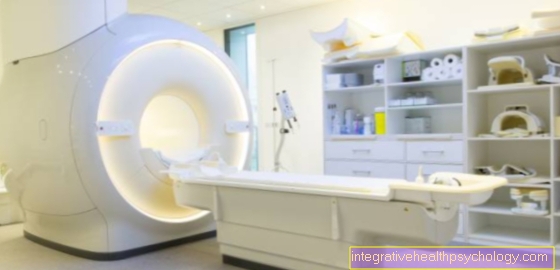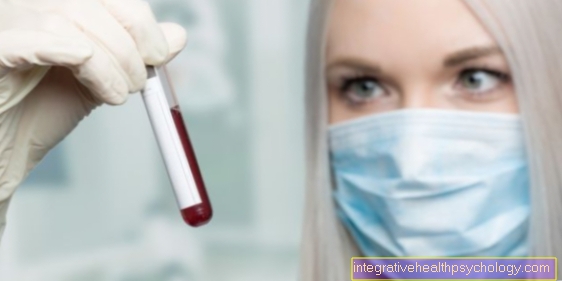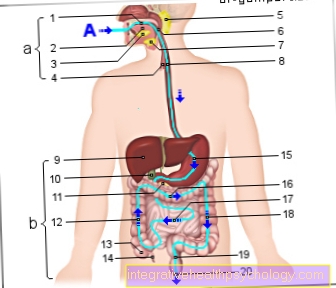Follow-up care after breast cancer
introduction
Follow-up care for breast cancer should be started after the operation or immediately after the end of the overall therapy and lasts for at least 5 years. The focus is on physical as well as psychosocial aspects. The leading tasks of aftercare consist of close-knit support and maintaining the success of the therapy. Help can be given in reintegration into everyday life, and possible rehabilitation can be organized. In addition, follow-up care should identify any therapeutic consequences, such as lymphedema, and address them early with appropriate therapy. In addition to the physical examination, mammography is an important diagnostic method in the context of follow-up care in order to be able to detect second tumors at an early stage.

What is the aftercare after breast cancer?
Follow-up care after breast cancer has been precisely structured by the Working Group for Gynecological Oncology. In the best case scenario, it begins during the postoperative therapy. At each follow-up appointment, a specific anamnesis is taken, in which the tolerance of the hormone or antibody therapy is checked and is intended to counteract discontinuation of the therapy. In addition, an early detection of Metastases can be achieved. Afterwards, an examination of the breasts is carried out at each appointment, which is also used for the early detection of secondary tumors and the wound healing is checked in the surgical or radiation field. Mammography is performed at fixed intervals. If the breast is completely removed, this is only done on the unaffected side. It is important that with breast-conserving therapy, both breasts must be examined in the mammography, as a second tumor can also develop in the breast that has already been operated on. Further diagnostics such as ultrasound examination of the breast (Breast sonography) or that MRI are only used if the findings are unclear and if a second tumor is suspected, as they show no advantage over the clinical examination.
You can find more information here: Detecting Breast Cancer
What does the follow-up care look like after breast cancer surgery?
At the beginning, the infection-free healing of the surgical wounds is in the foreground. These are more extensive when the breast is completely removed than with breast-conserving therapy. Attention is paid to excessive hardening of the scars, large bruises or inflammation. If lymph nodes were removed from the armpit during the operation, you must pay attention to any lymphedema that may develop during the operation by measuring the circumference of the arm. Should lymphedema occur, these can then be treated in a timely manner using various measures. Even the smallest nerves can be damaged during the lymph node removal, as these run close to the lymph nodes. This leads to discomfort or pain in the shoulder or upper arm after the operation. This so-called nerve pain must be recognized and treated at an early stage in follow-up care, as otherwise it will develop into chronic pain. If the breast has been completely removed, it is also the task of the aftercare to inform the patient about the possibilities of breast augmentation and, if approved, to initiate the necessary steps.
You can find more information on the subject here: Breast cancer surgery
What is the aftercare after chemotherapy?
In the follow-up appointments after chemotherapy either before or after an operation, specific attention is paid to side effects and damage caused by chemotherapy. Anthracyclines, for example, are one of the most important chemotherapy drugs in the treatment of breast cancer. They can, however, also damage the heart, which is why regular ultrasound examinations of the heart are useful. In general, chemotherapeutic agents damage the gastric and intestinal mucosa, which is why you should watch out for infections in the gastrointestinal tract. Another well-known side effect of chemotherapy to look out for is the suppression of the bone marrow, which is characterized by increased infection, spontaneous bleeding, or fatigue.
Further information on the subject can be found here: Chemotherapy for breast cancer
What is the aftercare after radiation treatment?
After a breast-conserving operation, the surgical field is re-irradiated. Especially during, but also after the irradiation, care must be taken to take good care of the skin with powder and wash with as little soap as possible. In the aftercare, damage to the skin, such as inflammation caused by the radiation, is observed and followed up on. The first mammography of both breasts should be performed 6-12 months after the end of the irradiation.
More information can be found here: Radiation for Breast Cancer
What about aftercare for triple-negative tumors?
Patients with triple-negative tumors receive chemotherapy before or after the operation. Antibody or hormone therapies are not effective for them. Therefore, in the follow-up care, in addition to the medical history and physical examination, particular attention is paid to side effects from the operation or chemotherapy. Triple-negative tumors are considered very malignant, which is why special emphasis should be placed on the early detection of secondary tumors.
How often do I have to go to the examination?
For the first three years, a check-up with anamnesis and clinical examination is carried out every quarter. From the 4th year onwards, this examination only takes place every six months and from the 6th year onwards at annual intervals. In addition, mammography must be performed at regular intervals. With breast-conserving therapy, the affected side is examined every six months for the first three years and annually from the fourth year. The unaffected side only needs to be examined once a year using a mammography. If the breast is completely removed, the unaffected side is examined every 12 months with a mammogram.
What is done in aftercare?
At the beginning of the check-up appointment, there is a detailed discussion with a doctor. At each check-up, the surgical scars are checked and the breasts or breasts and the lymph nodes in the armpit are palpated. The patient is also instructed in the first appointments and asked to perform a regular palpation examination on herself. Further physical examination includes weight control, measurement of the arm circumference and examination of the lungs and liver. In addition, a gynecological examination of the genital organs is carried out at regular intervals.
What is the aftercare pass?
The follow-up pass was introduced in 2011 and is intended to help all doctors involved in follow-up care to be kept up to date quickly. All follow-up appointments and important contact details for doctors are entered in it, so that it can also provide assistance to patients.Furthermore, the exact type of tumor and which therapies were carried out during the primary therapy concept are entered in the follow-up passport. In a further section, other diseases and the current medication can be entered.
Mammography in breast cancer follow-up
Mammography is used to detect secondary tumors in the breast on the primary affected side or on the other side at an early stage. It takes place once a year during aftercare. Breast-conserving surgery is an exception, as the operated breast is examined every 6 months for the first three years with a mammography. In breast-conserving therapy, it is also important to have a mammogram on both breasts, while in the case of complete breast removal it is sufficient to examine the unaffected side.
You can find more information here: Mammography
Breast MRI scans in breast cancer follow-up
An MRI of the breast is not carried out regularly during follow-up care because the diagnostic accuracy is no better than the regular medical history with physical examination combined with mammography. In addition, the early detection of the recurring tumor does not bring the patient any benefit in terms of survival, so that expensive and complex procedures such as MRI only play a subordinate role in follow-up care.
You may also be interested in this article: MRI in breast cancer
Scintigraphy in breast cancer follow-up
Scintigraphy of the skeleton is an examination method to detect metastases in the bones with radioactive substances. Similar to MRI, routine bone scintigraphy is not performed during follow-up. Scintigraphy is only useful for patients who complain about new pain in the back, for example, in the follow-up consultation or who have unexplained bone fractures during the follow-up, as bone metastases are suspected.
You may also be interested in this article: Breast cancer metastasis





























